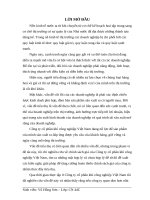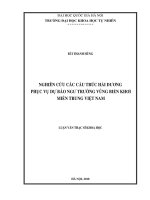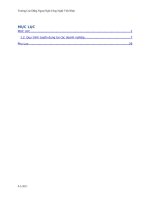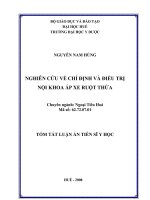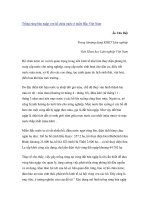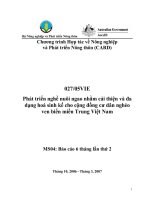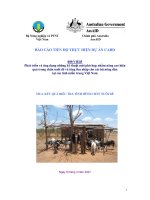Nghiên cứu về chi phí cho điều trị bệnh ung thư vú ở miền trung Việt Nam
Bạn đang xem bản rút gọn của tài liệu. Xem và tải ngay bản đầy đủ của tài liệu tại đây (320.92 KB, 10 trang )
Cost of treatment for breast cancer in
central Vietnam
Nguyen Hoang Lan
1,2
, Wongsa Laohasiriwong
3
*,
John Frederick Stewart
4
, Nguyen Dinh Tung
5
and
Peter C. Coyte
6
1
Graduate School, Khon Kaen University, Khon Kaen, Thailand;
2
Hue College of Medicine and
Pharmacy, Hue University, Hue city, Vietnam;
3
Faculty of Public Health and Board Committee of
Research and Training Center for Enhancing Quality of Life of Working Age People (REQW), Khon
Kaen University, Khon Kaen, Thailand;
4
Department of Economics, University of North Carolina,
Chapel Hill, USA;
5
Department of Oncology, Hue Central Hospital, Hue city, Vietnam;
6
Institute of
Health Policy, Management and Evaluation, University of Toronto, Toronto, Ontario, Canada
Background: In recent years, cases of breast cancer have been on the rise in Vietnam. To date, there has been
no study on the financial burden of the disease. This study estimates the direct medical cost of a 5-year
treatment course for women with primary breast cancer in central Vietnam.
Methods: Retrospective patient-level data from medical records at the Hue Central Hospital between 2001
and 2006 were analyzed. Cost analysis was conducted from the health care payers’ perspective. Various direct
medical cost categories were computed for a 5-year treatment course for patients with breast cancer. Costs, in
US dollars, discounted at a 3% rate, were converted to 2010 after adjusting for inflation. For each cost
category, the mean, standard deviation, median, and cost range were estimated. Median regression was used
to investigate the relationship between costs and the stage, age at diagnosis, and the health insurance coverage
of the patients.
Results: The total direct medical cost for a 5-year treatment course for breast cancer in central Vietnam was
estimated at $975 per patient (range: $11.7Á$3,955). The initial treatment cost, particularly the cost of
chemotherapy, was found to account for the greatest proportion of total costs (64.9%). Among the patient
characteristics studied, stage at diagnosis was significantly associated with total treatment costs. Patients at
later stages of breast cancer did not differ significantly in their total costs from those at earlier stages however,
but their survival time was much shorter. The absence of health insurance was the main factor limiting service
uptake.
Conclusion: From the health care payers’ perspective, the Government subsidization of public hospital
charges lowered the direct medical costs of a 5-year treatment course for primary breast cancer in central
Vietnam. However, the long treatment course was significantly influenced by out-of-pocket payments for
patients without health insurance.
Keywords: breast cancer; direct medical cost; health care payer; Vietnam
Received: 29 May 2012; Revised: 30 December 2012; Accepted: 3 January 2013; Published: 4 February 2013
B
reast cancer is the most common cancer among
women worldwide (1). Advances in screening
programs and treatment methods have improved
the life expectancy of patients with breast cancer (2).
From a societal perspective, the economic burden of this
disease has been reported in several studies using avail-
able data in developed countries; however, the direct
medical cost is thought to make the smallest contribution
to total costs, accounting for 50% of indirect costs
(morbidity and mortality) (3, 4). These medical costs,
while a small proportion of overall costs, may overwhelm
patients, particularly those with lower incomes. A study
by Chu et al. in Taiwan found that, among major cancers,
breast cancer was associated with the largest total life-
time medical costs at 5,046 million TWD (5). In the
United States, Barron et al. (2008), using pooled admin-
istrative data for five US health plans, estimated costs of
breast cancer treatment per patient per month at $2,896
or approximately at $34,752 per year (6). Medical costs
were found to increase with the stage of the disease (3, 4,
6, 7). In 1996, Legorreta et al., using US medical records
and claims data, determined that costs over a 4-year
(page number not for citation purpose)
æ
PUBLIC HEALTH IN VIETNAM: HERE’S THE DATA, WHERE’S THE ACTION?
Glob Health Action 2013. # 2013 Nguyen Hoang Lan et al. This is an Open Access article distributed under the terms of the Creative Commons Attribution-
Noncommercial 3.0 Unported License ( permitting all non-commercial use, distribution, and reproduction
in any medium, provided the original work is properly cited.
1
Citation: Glob Health Action 2013, 6: 18872 - />period for patients with stage III breast cancer averaged
more than $60,000, whereas costs were lower in patients
at stage 0, I, and IV at $19,000, $21,000, and approxi-
mately $40,000, respectively (8).
Breast cancer has also become an important public
health problem in Vietnam. The incidence rate increased
from 13.8 per 100,000 women in 2000 to 28.1 per 100,000
women in 2010. In 2010, it was reported that there were
12,533 women with breast cancer in the country (9). In
Vietnam, as in many other developing countries, breast
cancer was characterized by late presentation, young
patients, and low survival rates (10Á13). Recent studies in
Vietnam have revealed that poor knowledge and aware-
ness among the general public is a major contributor to
those problems (13). However, the financial burden of
treatment of breast cancer has not yet been considered as
a contributing factor. The objective of this study is to
provide estimates of the total direct medical costs for
breast cancer treatment in central Vietnam. The findings
can contribute to models of cost-effectiveness analysis
of interventions for breast cancer and can support policy
adaptations for better care of the women with this disease
in Vietnam.
Methods
Study design
A retrospective study was designed to estimate the cost
of treatment for women with breast cancer in central
Vietnam. Medical records of patients with a code of C 50
(ICD-10 version) admitted to Hue Central Hospital
(HCH) between 2001 and 2006 were searched to identify
breast cancer patients presenting in those years (14).
Data, from medical records and participant’s recall, on
the patients’ costs for medical care for breast cancer were
collected for a period of 5 years following primary
diagnosis. Calculation of expenditure for breast cancer
treatment was based on actual patient-level cost data,
excluding the costs for herbal treatment or unpaid
family care, because it is difficult to control these costs,
especially in the context of the many variations of herbal
medicines in Vietnam. Unit costs during the period of
study were provided from the financial department of the
hospital. The direct medical cost of treatment for women
with breast cancer was analyzed from the perspective
of health care payers, including the cost borne by patients
and health insurance providers. The payment amount
or hospital fee included the cost of medications and
materials used in clinical practice together with the user
fees borne by patients. User fees are based on a decree on
partial collection of public hospital fees as regulated
by the Vietnamese government (1994) and the decree’s
revisions (15, 16). The direct non-medical costs (e.g.
travel, accommodation, time) and indirect costs (e.g. lost
income or premature death due to the disease) were not
included in these calculations.
Data sources
The data were collected from two sources:
Primary data: Patients or their relatives (if patients
were deceased) were interviewed directly using a struc-
tured questionnaire. Data on sociodemographic charac-
teristics, the type of initial treatment received during
hospitalization as well as during a 5-year follow-up
period after the initial treatment, and compliance with
the treatment regime for follow-up care were collected.
For deceased patients, the date and cause of death were
also noted.
Secondary data: The paper charts stored at Hue
Central Hospital of patients with breast cancer were
examined to obtain personal information (e.g. name, age,
home address), date of admission, diagnosis and stage,
treatment regimes, itemized invoices, and health insur-
ance participation. Unit costs for treatments received
over the study period were acquired from the hospital’s
finance department.
Study population
HCH was selected as the site for the study. This hospital
is located in the city of Hue, the capital of the central
coastal Thua Thien Hue province. HCH is one of the
three largest hospitals under the management of the
Ministry of Health in Vietnam. The hospital is a national
general hospital and a leading referral hospital in the
central region. The medical records of patients presenting
with breast cancer at HCH were screened to identify
those meeting the following criteria Á inpatient admission
to the hospital between January 2001 and January 2006,
residents of Thua Thien Hue province, diagnosis of pri-
mary breast cancer identified in the paper charts by the
occurrence of code C 50 (ICD-10 version), and evidence
of stage of breast cancer according to the tumor/nodes/
Policy recommendations from the study
. Earlier diagnosis of breast cancer should be enabled through screening programs to increase treatment
effectiveness and to save health care resources.
. Universal health insurance coverage should be given more attention, especially since public hospital charges are
expected to increase in the near future.
. The Vietnamese government should have a policy to support cancer patients when the cost of their illness is
expected to exceed their ability to pay (with or without health insurance).
Nguyen Hoang Lan et al.
2
(page number not for citation purpose)
Citation: Glob Health Action 2013, 6: 18872 - />metastasis (TNM) staging system of the Union for
International Cancer Control (UICC) (17); 160 patients
were identified according to the criteria for inclusion
and tracked until December 31, 2010, to determine their
5-year survival time. The time period from 2001 to 2006
was used to obtain a more comprehensive sample of
patients at various stages of breast cancer from different
age groups. This long time period was necessary because
the incidence rate of the disease in Thua Thien Hue
province was not high (9). The results of follow-up left
129 eligible patients for whom costs could be analyzed.
The main reason for 31 cases being lost to follow-up was
migration to another treatment site.
Diagnosis to define breast cancer
In HCH, between 2001 and 2006, major laboratory tests
were often requested to define breast cancer, including
breast ultrasound, hematogram, CA 15.3, tumor biopsy,
and cytological tests. Some patients might also have had
mammography and estrogen receptor (ER) tests, pro-
gesterone receptor (PR) tests, and Her 2-Neu tests from
other health facilities in the province or in the country
(personal communication, Dr. Nguyen Dinh Tung, On-
cology Department, Hue Central Hospital). In this study,
only those tests recorded in the patients’ medical records
were included.
Treatment pattern for breast cancer between 2001
and 2006
During the study period, advanced medical equipment
and new medications were in limited use in public
hospitals in Vietnam. The most common guidelines used
in Vietnam for the treatment of breast cancer are reported
in Table 1 (personal communication, Dr. Nguyen Dinh
Tung, Oncology Department, Hue Central Hospital).
Initial treatment
The first, or initial, treatment was implemented after the
patient received a positive diagnosis for breast cancer.
A range of methods was used, depending on the stage of
the breast cancer and the characteristics of the patient.
The most common treatment methods were surgery,
radiation therapy, chemotherapy, and hormone therapy,
either alone or in combination. Surgery involved either
a complete mastectomy or breast-conserving surgery
combined with axillary lymph node dissection. Bilateral
oophorectomy might also have been performed. At the
time of the study, radiation was delivered with a cobalt-60
unit. Different chemotherapy regimes were used, with
the most common being FAC (a combination of cyclo-
phosphamide, doxorubicin, and 5-fluorouracil), FEC 120
(cyclophosphamide, epirubicin, and 5-fluorouracil), and
a combination of paclitaxelÁdoxorubicin. Tamoxifen
was often used for hormone therapy. Before treatment
began, patients were assessed by laboratory tests based
on the proposed approach and regime. Specialists often
requested tests, such as hematograms, chest X-rays,
kidney or liver function tests (SGOT, SGPT), CA 15.3,
and breast and abdominal ultrasound. The choice of tests
varied considerably depending on the doctor and the
characteristics of each patient. For patients on che-
motherapy, the initial treatment often lasted for up to
9 months, but the duration was less for patients not on
chemotherapy.
Follow-up care
Breast cancer treatment has a long course. Normally,
patients are required to continue with follow-up care
after completing an initial treatment so as to detect local
recurrence or metastasis. This type of care was included
as ‘follow-up care and supportive treatment’ in this
study. During follow-up, outpatient appointments were
scheduled every 3 months over the first 2 years and every
6 months in subsequent years. Physical examinations
together with laboratory tests, such as hematograms,
hepatic ultrasounds, chest X-rays, and CA 15.3, were
performed at every out-patient visit. During this time
period, most patients were prescribed tamoxifen daily
(personal communication, Dr. Nguyen Dinh Tung,
Oncology Department, Hue Central Hospital). Since
2006, prescribing tamoxifen has depended on the result
of ER tests. In addition, selected patients with signs of
Table 1
. Treatment patterns for breast cancer in Vietnam, 2001Á2006
Stage of diagnosis Applied treatment
I Breast surgery, including mastectomy or breast-conserving surgery with/without axillary dissection. Eligible patients
received hormone therapy.
II Mastectomy breast surgery with axillary dissection. Bilateral oophorectomy by surgery or radiation, if
pre-menopause. Adjuvant radiation was supplemented with either external radiotherapy to the breast,
chemotherapy, or both. Eligible patients also received hormone therapy.
III Chemotherapy followed by mastectomy with axillary dissection supplemented with adjuvant chemotherapy.
External radiotherapy to the breast was also administered and eligible patients received hormone therapy.
IV Chemotherapy and/or radiation therapy were supplemented with hormone therapy for eligible patients.
Cost of breast cancer treatment in Vietnam
Citation: Glob Health Action 2013, 6: 18872 - 3
(page number not for citation purpose)
recurring tumors received supportive treatment, which
might consist of up to six cycles of chemotherapy and/or
radiation therapy.
Cost analysis
Costs were divided into three categories: cost of diagnosis,
cost of treatment, and cost of follow-up care. Costs of
diagnosis comprised the total cost of laboratory tests that
patients received to confirm the diagnosis of breast cancer.
Treatment costs included surgery, chemotherapy, radia-
tion therapy, hormone therapy and supportive medica-
tion, plus inpatient fees. Cost of initial treatment was
specified as the combination of the cost of diagnosis and
the cost of treatment, which was calculated on the basis of
data collected from medical records of individual patients.
Cost of follow-up care included supportive treatment
as well as fees for laboratory tests, out-patient visits, and,
in some cases, the cost of a dose of tamoxifen. With our
focus only on breast cancer, we assumed that all patients
were administered the same tests on every outpatient
visit. The compliance of patients with a 5-year period of
follow-up care was defined as their conformation to out-
patient visits and hormone therapy. A questionnaire that
provided information about compliance with the course
of treatment on the basis of repeated outpatient appoint-
ments and doses of medication was designed. These data
were obtained through patient interviews (or interviews
with their relatives if the patient was deceased) at the time
of the study. We assumed that an affirmative response
concerning regular outpatient visits and/or compliance
with the tamoxifen regime meant that they were in
complete compliance with the standard treatment course
(until death or the stated end time). If the respondents
said ‘sometimes’ or ‘partial compliance’, we set their care
pathway to be 50% of the standard follow-up care. When
they said ‘no’, patients were defined as non-compliant,
and, accordingly, we set their follow-up care to zero.
Costs were estimated based on unit cost of tests, out-
patient fees, and price of tamoxifen over time. For
supportive treatment, we used the data collected from
medical records during the 5 years after diagnosis (if
records were available). Costs were discounted at an
annual rate of 3% as recommended by the World Health
Organization (WHO) (18). These costs were then con-
verted to 2010 figures on the basis of the annual inflation
index in Vietnam (19). The cost analysis was performed
using the following two methods:
1. Cost analysis by category: For cost categories, ag-
gregate 5-year cost and annual total cost, the mean,
standard deviation, the median and cost range were
estimated. Values of median for costs were com-
pared with estimates of median regression in the
further cost analysis. Costs were presented in US
dollars for comparison purposes. The exchange
rate used was that in effect on July 15, 2010
(1USD018544 VND) (20).
2. Cost analysis by key characteristics of patients:
Because of non-normally distributed cost data
(ShapiroÁWilk test, p-valuesB0.001), a quantile
regression model was used to analyze the relationship
between characteristics of patients and treatment
costs for breast cancer. First, key characteristics
of the study population, such as stage at diagnosis,
health insurance coverage, and age group, were
incorporated in a median regression model to deter-
mine factors affecting the 5-year total cost for breast
cancer. From this analysis, variables with p-value
B0.05 were analyzed further in a median regression
to estimate the difference in median of cost categories
according to their groups. The median difference
among groups was presented along with p value and
their 95% CI. Differences among groups were con-
sidered to be statistically significant when the p value
was 5 0.05.
Sensitivity analysis
According to statistics from the Ministry of Health, user
fees accounted for 60Á70% of all hospital revenues in
2006, the rest were from the government budget and
other sources (21). Sensitivity analysis, which added
30Á40% to unit costs, presented costs for breast cancer
treatment with the government budget supplement.
Table 2
. Characteristics of patients with breast cancer in
Hue Central Hospital
Characteristics Number of patients Percentage
Age at diagnosis (years)
Mean (SD) 51 (9.5)
Range 33Á75
B40 16 12.4
40Á49 47 36.4
50Á59 42 32.6
60Á69 17 13.2
]70 7 5.4
Residence
Urban 67 51.9
Rural 62 48.1
Health insurance coverage
Yes 68 52.7
No 61 47.3
Stage of breast cancer
at diagnosis
I 9 7.0
II 73 56.6
III 35 27.1
IV 12 9.3
Nguyen Hoang Lan et al.
4
(page number not for citation purpose)
Citation: Glob Health Action 2013, 6: 18872 - />Results
Study subject characteristics are reported in Table 2.
The mean age of patients at the time of diagnosis was 51
years (range 33Á75 years). The most frequent age group
was that from 40 to 49 years (36.4% of the patients).
The study population was evenly divided between urban
(51.9%) and rural (48.1%) residences. Slightly more
than half of the study population had health insurance
(52.7%). At primary diagnosis, the majority of the women
had been diagnosed with stage II breast cancer (56.6%).
Late-stage diagnosis (stage III and IV) was also common,
accounting for 27.1% and 9.3% of the study population,
respectively.
More patients with health insurance reported complete
or partial compliance than did patients without insur-
ance. The proportion of patients dropping out of treat-
ment was larger among patients without health insurance
than among those with health insurance (26.2% vs. 5.9%)
(Table 3).
Figure 1 presents estimates of survival probabilities of
up to 5 years for patients with breast cancer by stage at
diagnosis. The survival rate was the lowest for late-stage
breast cancer, with 43% of patients at stage III and no
cases at stage IV surviving as long as 5 years following
diagnosis. Patients at stage I and II at the time of primary
diagnosis had higher survival rates after 5 years at 78%
and 73%, respectively (log-rank test showed p-value
B0.001).
Table 4 displays the cost of the different components of
treatment, following the primary diagnosis. Women with
breast cancer faced a mean cost estimated at $632.85 per
patient over the first 9 months of treatment, but the range
was very wide ($11.70Á$3955.40). The highest average
cost incurred was for chemotherapy, at $476.48 per
patient. The cost for surgery was also considerable, at
$82.35 per patient regardless of whether the method
was a complete mastectomy or breast conservation. The
lowest treatment cost was for hormone therapy, at only
$4.25. Costs for follow-up care over a 5-year period after
primary diagnosis included supportive treatment and
other follow-up care as described earlier. The mean total
cost for follow-up was estimated at $356.24 per patient,
with the greatest proportion of costs for follow-up care
($342.18). Aggregated costs over the 5-year treatment
course for breast cancer were on average $975.01 per
patient but with a wide range ($11.70 to $3955.40).
The annual average cost during the 5 years of treatment
was an average of $195 per patient.
Figure 2 shows that the stage at diagnosis was
significant in terms of the 5-year total cost for breast
cancer treatment (p00.001), but there were no significant
differences in median total costs related to patient age
(p00.329) or whether or not they had health insurance
(p00.468).
As shown in Table 5, further analysis of the relation-
ship between stage at diagnosis and different cost
categories revealed that costs increased with stage at
diagnosis for the initial treatment period. The median
costs were $128.70, $368.80, $684.10, and $537.90 for
stage I, II, III, and IV, respectively. The difference in
initial treatment cost among stages was statistically
significant (p-valuesB0.05). By contrast, cost analysis
for follow-up care showed that patients with earlier stages
at diagnosis faced higher costs because they survived for
a longer time period (p-valuesB0.001). The patients with
stage II incurred the highest median cost ($516.50),
followed by those with stage I ($409.20) for follow-up
care. These costs were lower at stage III ($218). Median
cost was estimated at $0 for follow-up care in patients
at stage IV because 50% of patients at this stage survived
less than a year after diagnosis (Figure 1). However,
median costs for aggregated 5-year total cost and annual
treatment cost revealed that patients at stage II incurred
$333.20 and $66.70 higher costs than those with stage I
for 5-year total cost or annual treatment cost, respectively
(p-value00.009) while variance in treatment costs for late
stages (stage III and IV) of breast cancer were not
statistically significant from stage I (p-values 0.05).
Data related to government subsidy and other sources
included in the estimates of treatment cost for breast
cancer at public hospitals are presented in Table 6. When
these funding sources were included, corresponding mean
and median total costs of 5-year treatment and mean and
median annual treatment cost were 40% to nearly 70%
higher (corresponding to the support of government of
30% and 40%, respectively).
Table 3
. Compliance with breast cancer treatment in relation to health insurance
Health insurance coverage (%)
Compliance Yes (95% CI) No (95% CI) Total (95% CI)
Complete compliance 76.5 (64.8Á85.2) 68.9 (56.1Á79.3) 72.9 (64.4Á79.9)
Partial compliance 17.6 (10.2Á28.7) 4.9 (1.6Á14.4) 11.6 (7.1Á18.5)
No compliance 5.9 (2.2Á14.8) 26.2 (16.6Á38.8) 15.5 (10.2Á22.9)
95% CI: 95% confidence interval; p00.0016 (Pearson’s chi-square test).
Cost of breast cancer treatment in Vietnam
Citation: Glob Health Action 2013, 6: 18872 - 5
(page number not for citation purpose)
Discussion
The results of this study showed that breast cancer was
common among young women in central Vietnam during
the study period. This is the general profile of breast
cancer in developing countries. In developed countries,
the majority of breast cancer patients are postmenopau-
sal, 60Á70 years old (1, 10). The low coverage of health
insurance among the study population was reflective of
the study period for Vietnam (22).
The majority of the women in the study population
were diagnosed at stage II breast cancer. During the study
period, increases in household income due to economic
growth and improvements in diagnostic methods for
breast cancer (such as the use of ultrasound) provided
opportunities for Vietnamese women to contact health
facilities and to have their disease detected at an earlier
stage than was likely in the past (13).
The costs presented in the study were adjusted to the
year 2010 by the growth in the consumer price index and
were annually discounted at 3%. The mean total cost of a
5-year course of treatment was estimated at $975.01, with
a wide range ($11.70Á$3955.40). The compliance with
treatment and the type of initial treatment influenced
this finding. Some patients refused treatment following
diagnosis or did not complete their course of treat-
ment. The majority of those patients that did not
complete their treatment course were those not covered
by health insurance (Table 3). Establishing a policy of
universal health insurance coverage in Vietnam would
positively impact the current lack of affordable access to
appropriate treatment for chronic diseases such as breast
cancer. Nevertheless, the costs determined by this study
were much lower than those reported for developed
countries. In France, for example, the mean medical
cost for a 5-year treatment period for breast cancer was
$10,744 (23). Groot et al. estimated the 10-year total cost
of treatment per patient with breast cancer based on data
retrieved from the WHO-CHOICE database in Africa,
Asia, and the Americas in 2000. They reported lower
estimates of $602, $356, and $8,530 for Africa, Asia,
and North America, respectively (24). These comparisons
Table 4
. Cost estimation per category of breast cancer treatment
Costs (US dollars)
Category Mean SD Median Range
Diagnosis 16.02 4.93 16.00 6.9Á33.20
Treatment
Surgery 82.35 31.82 83.00 0.0Á235.70
Chemotherapy 476.48 752.81 379.40 0.0Á3772.7
Radiation therapy 22.87 37.57 9.00 0.0Á300.60
Hormone therapy 4.25 15.20 0.00 0.0Á109.60
Other (supportive medication) 4.50 14.34 0.00 0.0Á93.10
Inpatient fee 26.38 12.17 24.60 0.0Á88.10
Initial treatment cost 632.85 754.54 509.00 11.7Á3955.4
Costs for follow-up care
Supportive treatment 14.06 75.08 0.00 0.0Á634.10
Cost for follow-up care 342.18 259.25 409.20 0.0Á901.70
Total cost for follow-up care 356.24 260.09 429.40 0.0Á901.70
5-Year total cost for treatment course 975.01 730.79 844.20 11.7Á3955.4
Annual treatment costs 195.00 146.16 168.80 2.3Á791.10
SD, standard deviation; costs are adjusted for inflation to the year 2010; discount rate03%; exchange rate in July 2010: 1 USD 018,544
VND.
Fig. 1. KaplanÁMeier estimates of 5-year survival probability
by stage of breast cancer.
Nguyen Hoang Lan et al.
6
(page number not for citation purpose)
Citation: Glob Health Action 2013, 6: 18872 - />are similar to a review by Radice et al. in which the
cost of breast cancer treatment in developing regions
was considered less than or equal to 5% of that in the
developed world (3). Comparisons among the wide range
of cost estimates for breast cancer treatment and generali-
zations drawn from economic studies on the disease are
made difficult by the different characteristics and patient
populations of each country. The diversified unit costs
for resource use in different countries could explain the
different findings. For instance, in the United Kingdom
in 2007, the cost of breast cancer surgery ranged from
£1,261 for conservative surgery to £2,073 for a mastec-
tomy, compared to the average cost of $82.35 (about £55
in 2010) for breast cancer surgery that we found in our
study (25). In Vietnam, public hospital charges did not
measure the full cost of health care resource usage. Unit
costs included the price of medications and materials
used in the course of treatment but only a portion of
those resources that were subsidized by government
policy, such as the hospital facility and clinical staff (15,
16). Sensitivity analysis showed that including the
government subsidy increased cost estimates by 40 to
70% (Table 6). However, even if user fees and government
subsidies were combined, hospital charges were still
underestimated. Remuneration of health staff and capital
depreciation have not been adequately estimated (26).
Unit costs in Vietnamese public hospitals and hospital
fees are, therefore, lower than the real cost of the
resources used. In a cost analysis of health services in
Vietnam, Flessa et al. (2004) determined that the unit
cost of an operation such as breast cancer surgery at a
central hospital was $175.89, double the cost of our
Table 5
. Variance in cost of breast cancer treatment according to stage at diagnosis
Cost category Median Median difference P 95% CI
Initial treatment cost
Stage I 128.7 0.0 0.218 (76.86Á334.26
Stage II 368.8 240.1 0.032 20.92Á459.28
Stage III 684.1 519.4 B0.001 286.74Á752.06
Stage IV 537.9 482.2 0.001 208.45Á334.26
Follow-up cost
Stage I 409.2 0.0 B0.001 383.91Á434.49
Stage II 516.5 107.3 B0.001 80.42Á134.18
Stage III 218.4 (109.8 B0.001 (219.43Á(162.17
Stage IV 0.0 (409.2 B0.001 (436.21Á(382.19
Aggregated 5-year total cost
Stage I 568.6 0.0 B0.001 334.74Á802.46
Stage II 901.8 333.2 0.009 83.86Á582.54
Stage III 816.1 247.5 0.067 (17.19Á512.19
Stage IV 603.4 42.30 0.789 (269.13Á353.73
Annual treatment cost
Stage I 113.7 0.0 B0.001 66.97Á160.43
Stage II 180.4 66.7 0.009 16.88Á116.52
Stage III 163.2 49.5 0.066 (3.39Á102.39
Stage IV 120.7 8.5 0.787 (53.73Á70.73
Cost unit: US dollars.
Characteristics of
patients
Age group
Health insurance
Stage at diagnosis
–200 –100 0 100 200
Median cost
difference
P
value
95% CI
–101.9 0.329
–42.4 0.468
–121.3 0.001
–307.8 to 103.9
–157.6 to 72.8
–194.9 to –47.7
Fig. 2. The relationship between key characteristics of patients and the total 5-year cost of the course of treatment for breast
cancer.
Cost of breast cancer treatment in Vietnam
Citation: Glob Health Action 2013, 6: 18872 - 7
(page number not for citation purpose)
findings (27). In addition, at the time of our study,
advanced treatment guidelines were not yet available in
Vietnam.
Initial treatment costs were found to be the most
expensive component of total costs, accounting for
$632.85; these costs represented 65% of the total cost,
compared to 63Á73.3% in previous studies (6, 7, 23).
Chemotherapy costs made up the highest proportion
of the initial treatment-attributable costs. In 2005,
Oestreicher et al. estimated the cost of chemotherapy
for US women with early-stage breast carcinoma to be
$23,019, which is 50 times greater than our estimate of
$476.48 for Vietnam in 2010 (28). The factors that may
contribute to high chemotherapy costs are the types of
chemotherapy agents used and the cost of supportive care
agents (2). The variety of chemotherapy regimens could
explain the wide range of estimated costs for initial
treatment as well as the total 5-year treatment course.
The regime with paclitaxelÁdoxorubicin was found to be
the most expensive treatment option for chemotherapy
over the study period. Many studies have compared
the cost-effectiveness of alternative chemotherapy re-
gimes for the treatment of breast cancer. For example,
the analysis reported by Mittmann (2010) showed that a
protocol with docetaxel offered improved life expec-
tancy but at a higher cost compared with fluorouracinÁ
adriamycinÁcyclophosphamid (FAC) (29). According to
the experience of the oncologists in HCH (personal
communication), the use of expensive chemotherapy regi-
mens depended on the patients’ ability to pay for them.
Research on the economic evaluation of different breast
cancer chemotherapy regimes should be conducted in
the Vietnamese context. The result will help health care
providers as well as patients in choosing an affordable
and effective treatment method. The high proportion of
chemotherapy costs is also a reason as to why initial
treatment costs were more for patients diagnosed at
stage II and higher; chemotherapy is recommended for
most of those patients (see Table 1). In fact, the costs of
chemotherapy in our study exceeded the total cost of
follow-up care over the 5 years after diagnosis ($476.48
vs. $356.24). Because follow-up treatment for breast
cancer in the years after the initial treatment was
relatively simple, as described in the method section, the
related costs were estimated to be small and relatively
stable, as was found in other studies (24, 30). For patients
diagnosed with stage I breast cancer, the initial treatment
costs were very low, but the follow-up care accounted for
a higher proportion of the total cost of treatment. The
opposite was true for the patients diagnosed with stage
IV. For late-stage breast cancers, the treatment was
ineffective. Our study revealed that patients diagnosed
at a late stage incurred the same costs as those diagnosed
at an early stage but had lower survival times. Early
detection of breast cancer may not only increase life
expectancy but could also result in resource savings for
health care (2, 3). Presently, a pilot screening program
for breast cancer has been introduced in some regions of
Vietnam. An economic evaluation is necessary before the
program will be available nationwide.
Because of underestimation of charges in public hos-
pitals, the annual direct medical cost for breast cancer
treatment in this study amounted to about 18% of gross
national income (GNI) per capita in Vietnam in 2010
($195 vs. $1,100) (31). A review by Pisu et al. revealed that
out-of-pocket costs for direct medical care were a sub-
stantial burden for low-income breast cancer survivors,
whose expenses for the disease within 1 year after
diagnosis amounted to 75% of their total annual income,
compared with only 8% for breast cancer survivors in
the highest income group (32). Out-of-pocket costs are the
main obstacle to medical treatment, especially in case of
diseases with a long natural history (such as breast
cancer). Indeed, our study found that a higher number
of patients in the group without health insurance coverage
dropped out of their treatment regime. Universal health
insurance coverage is not yet a reality in Vietnam but
should be given more attention, especially since public
hospital charges are expected to increase in the near future.
The government should have a policy to support cancer
patients for whom the cost of illness exceeds their ability to
pay or even to co-pay for health insurance. In addition, if a
network of primary health care were to be established
throughout the country, alternatives such as home care
and community care should be promoted to provide
health care services to patients who require long-term
care, following an initial hospital stay (such as breast
cancer patients). The shift to home care settings may
improve the compliance with treatment and reduce out-of-
pocket costs for patients in Vietnam, where the access to
health facilities for cancer treatment has been limited (33).
A number of factors should be considered when inter-
preting the findings of this study. The data were collected
over the period 2001 to 2006 and do not reflect current
Table 6
. Estimated costs, including the government subsidy
and other sources
Cost category
Coverage of government
5-Year total cost
Annual treatment
cost
budget and other sources Mean Median Mean Median
30% 1392.9 1206 278.57 241.14
40% 1625.0 1407 325.00 281.33
Baseline 975.01 844.20 195.00 168.80
Cost unit: US dollars.
Nguyen Hoang Lan et al.
8
(page number not for citation purpose)
Citation: Glob Health Action 2013, 6: 18872 - />utilization of advanced treatment methods and new
medications for breast cancer treatment. The analysis
was limited to costs of primary breast cancer cases,
excluding recurrent cases. Both of these factors could
lead to an underestimation of the costs. The exclusion of
the governmental subsidy and other resources in our cost
estimates meant that our estimates did not represent the
‘complete’ resource costs incurred for the treatment of
breast cancer in Vietnam, although the estimates do
reflect the full costs borne by health care payers. Many
changes in the socioeconomic structure of Vietnam
occurred during the study period and continue to the
present. These changes in the socioeconomic environment
might limit the ability to generalize from these study
results. In addition, precise data were not available for
much of the follow-up period for care; these costs were
mainly estimated based on the patient’s (or relative’s)
recall of at least 5 years and therefore are subject to
potential bias. Although efforts were made to enroll a
suitable number of cases in the analysis, the low incidence
rate of breast cancer in Thua Thien Hue province
combined with limitations of medical record preservation
before 2008 resulted in a small sample size. This affected
the opportunity to identify significant differences in
cost comparisons among various groups of patients.
The estimated costs for breast cancer treatment might
not be representative of other main public hospitals in
Hanoi and Ho Chi Minh City or of private hospitals in
Vietnam, where unit costs may differ from those in our
study (15, 16), thereby limiting the ability to generalize
our study findings. Despite these limitations, the cost
estimates in this article provide the first piece of evidence
regarding the cost of breast cancer treatment in Vietnam.
These findings reflect the financial burden on health care
payers at public hospitals. They will contribute important
information to cost-effectiveness analysis of interventions
for breast cancer and will help decision-makers engaged
in health system planning and resource allocation.
Conclusion
The direct medical costs of a 5-year course of treatment
for primary breast cancer in central Vietnam are much
lower than in developed countries. The exclusion of
government subsidies and other resources lowered the
total costs included in our analysis. However, the long
treatment course significantly influenced out-of-pocket
payments by patients without health insurance. Having
health insurance increased patients’ compliance with
treatment because the ability to pay played a major role
in treatment uptake. The initial treatment, especially
chemotherapy, accounted for the largest part of total
costs though the range in costs was wide. There is no
significant difference in 5-year total cost with regard to
age at diagnosis, health insurance coverage, and between
early- and late-stage breast cancer patients in the study.
Patients diagnosed with late-stage breast cancer incurred
higher costs for initial treatment than those diagnosed at
early stages, while their survival time was shorter. Facing
these challenges, early detection of breast cancer through
screening programs, access to relevant treatment, and an
increase in health insurance coverage along with other
financial supports to chronic patients should be imple-
mented to improve access to care and the prognosis of
breast cancer patients in Vietnam.
Acknowledgments
We thank Prof. Pamela Wright, Director of Medical Committee
Netherland Vietnam for editorial assistance. We also thank Assoc.
Prof. Bandit Thinkhamrop for his advice on statistical analysis.
Ethical approval
Ethical approval for primary and secondary data collec-
tion was obtained from the University of Khon Kaen,
Thailand (where the study was designed as part of a
doctoral study program). In addition, approvals for
implementing the study at the various study sites were
obtained from the Provincial Health Service of Thua
Thien Hue province.
Conflict of interest and funding
The authors have no potential conflict of interest. The
research was funded by the VietnamÁNetherland Project
at Hue College of Medicine and Pharmacy, Vietnam, and
Graduate School of Khon Kaen University, Thailand.
References
1. Peter B, Bernard L., editors. World Cancer Report 2008 [online].
WHO press. The International Agency for Research on
Cancer (IARC). Available from: www.iarc.fr/en/publications/
pdfs_online/wrc/2008/wcr_2008.pdf. [cited 17 June 2011].
2. Anderson BO, Yip CH, Smith RA, Shyyan R, Sener SF, Eniu A,
et al. Guideline implementation for breast healthcare in
low-income and middle-income countries. Overview of the
breast health global initiative global summit 2007. Cancer
2008; 113(Suppl. 8): 2221Á43.
3. Radice D, Redaelli A. Breast cancer management: quality-of-life
and cost considerations [abstract]. Pharmacoeconomics 2003;
21: 383Á96.
4. Pallis A, Tsiantou V, Simou E, Maniadakis N. Pharmacoe-
conomic considerations in the treatment of breast cancer.
Clinicoecon Outcomes Res 2010; 2: 47Á61.
5. Chu PC, Hwang JS, Wang JD, Chang YY. Estimation of the
financial burden to the national health insurance for patients
with major cancers in Taiwan [abstract]. J Formos Med Assoc
2008; 107: 54Á63.
6. Barron JJ, Quimbo R, Nikam PT, Amonkar MM. Assessing
the economic burden of breast cancer in a US managed care
population [abstract]. Breast Cancer Res Treat 2008; 109:
367Á77.
7. Will BP, Berthelot JM, Le Petit C, Tomiak EM, Verma S, Evans
WK. Estimates of the lifetime costs of breast cancer treatment in
Canada [abtract]. Eur J Cancer 2000; 36: 724Á35.
Cost of breast cancer treatment in Vietnam
Citation: Glob Health Action 2013, 6: 18872 - 9
(page number not for citation purpose)
8. Legorreta AP, Brooks RJ, Leibowitz AN, Solin LJ. Cost of
breast cancer treatment. A 4-year longitudinal study. Arch
Intern Med 1996; 156: 2197Á201.
9. Duc NB. Epidemiology and program of control and prevention
for cancer: preliminary report of National Cancer Project period
2008Á2010. Vietnamese J Oncol 2010; (1): 21Á6. Vietnamese.
10. Anyanwu SN. Temporal trends in breast cancer presentation in
the third world. J Exp Clin Cancer Res 2008; 27: 17.
11. World Health Organization (2010). Breast cancer: prevention
and control. Available from: />breastcancer/en/index.html [cited 12 September 2010].
12. Ngoan le T, Lua NT, Hang LT. Cancer mortality pattern in Viet
Nam. Asian Pac J Cancer Prev 2007; 8: 535Á8.
13. Anh PT, Duc NB. The situation with cancer control in Vietnam.
Jpn J Clin Oncol 2002; 32(Suppl. 1): S92Á7.
14. World Health Organization (2012). International classification
of diseases 10th revision. ICD-10 version: 2010. Available from:
[cited 16
January 2012].
15. Regulation of Vietnamese Government (1994). Partially collec-
tion of hospital fee. Decree No 95/CP. Available from: http://
www.hspi.org.vn/vcl/Thong-tu-Lien-Bo-y-te Tai-chinh Lao-
dong-TBXH Ban-Vat-gia-Chinh-phu-so-14TTLB-ngay-30-thang-
9-nam-1995-Huong-dan-thuc-hien-viec-thu-mot-phan-vien-phi-
t96Á1037.html [cited 27 August 1994].
16. Regulation of Vietnamese Government. Revised some points of
interministerial circular number 14/TTLB dated 30 September
1995. Circular No 11/TTLB dated 19 September 1997.
17. TNM Classification Help (2012). Breast tumours. Available
from: />html [cited 2012 March 21].
18. Tan-Torres T, Baltussen R, Adam T, Hutubessy R, Acharya A,
Evans BD, et al., editors. Making choices in health: WHO guide
to cost-effectiveness analysis. Geneva: World Health Organiza-
tion, 2003.
19. Vietnamese General Statistics Office (2011). Statistics of con-
sumer price index by year. Available from: .
[cited 20 November 2011].
20. Ministry of Finance. Rate of Exchange in July 2010. Available
from: />p_folder_id=3817325&p_recurrent_news_id=14280946 [cited 20
February 2012].
21. Ministry of Health (2006). Report of health care activities in
2006. Summation Conference for Hospital Activities in
Vietnam, Hanoi: Department of Therapy, Ministry of Health.
22. Long TG. Vietnam: Social health insurance: Current issues and
policy recommendations. The ILO’s Asia-Pacific Regional High-
Level Meeting on Socially-Inclusive Strategies to Extend
Social Security Coverage. Bangkok: the International Labor
Organization (ILO); 2008.
23. Lilliu H, Stevens D, Brun C, Morel J, Pen CL, Bonastre J, et al.
Cost of treatment and follow up of breast cancer: a retrospective
assessment in a comprehensive cancer centre. Bull Cancer 2002;
89: 635Á42.
24. Groot MT, Baltussen R, Uyl-de Groot CA, Anderson BO,
Hortobagyi GN. Costs and health effects of breast cancer
interventions in epidemiologically different regions of Africa,
North America, and Asia. Breast J 2006; 12(Suppl. 1): S81Á90.
25. Karnon J, Kerr GR, Jack W, Papo NL, Cameron DA. Health
care costs for the treatment of breast cancer recurrent events:
estimates from a UK-based patient-level analysis. Breast J Can
2007; 97: 479Á85.
26. Health Services of Ho Chi Minh City (2006). The implementa-
tion of policy on health socialization in Ho Chi Minh City.
Document No 4422/SYT-QLDVYT. Available from: http://
www.medinet.hochiminhcity.gov.vn/data/news/2006/8/3887/thxhh.
htm [cited 2012 May 25].
27. Flessa S, Dung NT. Costing of services of Vietnamese hospitals:
identifying costs in one central, two provincial and two district
hospitals using a standard methodology. Int J Health Plann
Manage 2004; 19: 63Á77.
28. Oestreicher N, Ramsey SD, McCune JS, Linden HM, Veenstra
DL. The cost of adjuvant chemotherapy in patients with early-
stage breast carcinoma. Cancer 2005; 104: 2054Á62.
29. Mittmann N, Verma S, Koo M, Alloul K, Trudeau M. Cost
effectiveness of TAC versus FAC in adjuvant treatment of node-
positive breast cancer. Curr Oncol 2010; 17: 7Á16.
30. Warren JL, Brown ML, Fay MP, Schussler N, Potosky AL,
Riley GF. Costs of treatment for elderly women with early-stage
breast cancer in fee-for-service settings. J Clin Oncol 2002; 20:
307Á16.
31. World Bank (2012). World development indicators database 1
July 2011. Available from: />DATASTATISTICS/Resources/GNIPC.pdf [cited 2012 February
11].
32. Pisu M, Azuero A, McNees P, Burkhardt J, Benz R, Meneses K.
The out of pocket cost of breast cancer survivors: a review.
J Cancer Surviv 2010; 4: 202Á9.
33. Vietnamscope. Situation: cancer situation [updated September
21, 2010]; Available from: />php?option0com_content&view0article&id099&Itemid0139
[cited May 25 2012].
*Wongsa Laohasiriwong
Faculty of Public Health
Khon Kaen University
Khon Kaen, 40002
Thailand
Tel: '66 897 121 455
Fax: '66 43347058
Email:
Nguyen Hoang Lan et al.
10
(page number not for citation purpose)
Citation: Glob Health Action 2013, 6: 18872 - />
